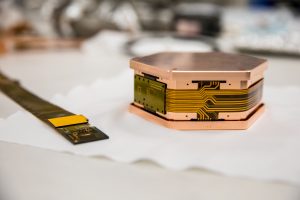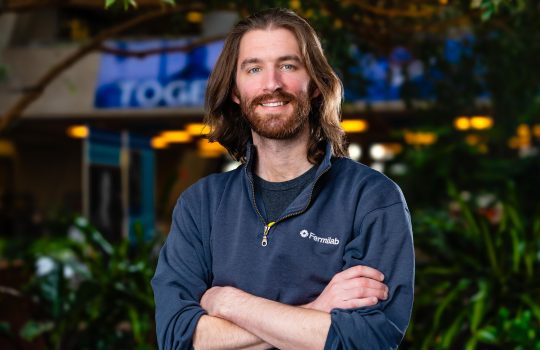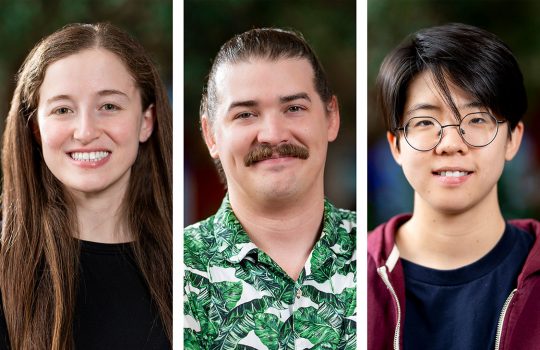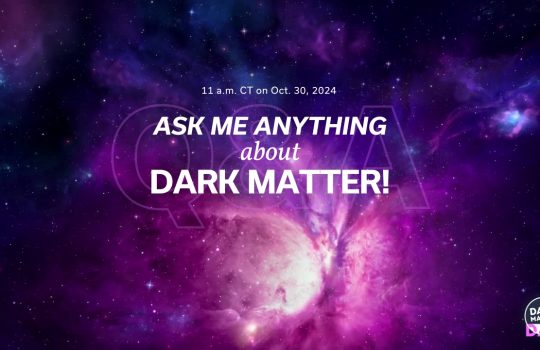Fermilab is providing technology and expertise for the SuperCDMS SNOLAB project, which will expand the hunt for dark matter to particles with properties not visible to any other experiment.
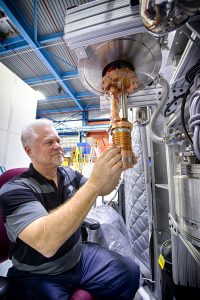
Fermilab’s Mark Ruschman tests prototypes for the SuperCDMS SNOLAB cryogenics system. Photo: Fermilab, Reidar Hahn
The U.S. Department of Energy Office of Science and the National Science Foundation have approved funding and start of construction for the SuperCDMS SNOLAB experiment, which will begin in the early 2020s to hunt for light dark matter particles. DOE’s Fermi National Accelerator Laboratory is playing a major role in building this new experiment, which is hosted at SNOLAB in Canada and managed by DOE’s SLAC National Accelerator Laboratory.
SuperCDMS SNOLAB will be at least 50 times more sensitive to low-mass dark matter particles than its predecessor, CDMS, at the Soudan Underground Laboratory, a Fermilab-led experiment that ended operation in 2015. SLAC is managing the SuperCDMS SNOLAB construction project for the international SuperCDMS collaboration of 111 members from 24 institutions in five countries.
“We are eager to resume our search for dark matter particles and explore an entirely new region of their possible interactions with normal matter,” said Fermilab scientist Dan Bauer, spokesperson of the SuperCDMS collaboration.
“Fermilab has been a leader in the search for dark matter for decades,” said Fermilab Director Nigel Lockyer. “We are proud to continue that involvement with the next generation of experiments, working with our U.S. and international colleagues at SNOLAB.”
A deeper, cleaner, colder search for dark matter
Scientists have long known that ordinary matter accounts for only 15 percent of all matter in the universe. The rest is a mysterious substance called dark matter. Due to its gravitational pull on regular matter, dark matter is a key driver in the formation of galaxies like our Milky Way. It therefore is fundamental to our very existence.
However, nobody knows what particles make up dark matter. Astronomical observations suggest that dark matter particles barely interact with the normal matter in the universe. Every so often, though, they could collide with an atom of our visible world, and dark matter researchers are looking for these rare interactions. These are difficult to spot in the presence of background interactions of normal matter particles from cosmic rays or small amounts of radioactivity in the environment.
In the SuperCDMS SNOLAB experiment, the search will be conducted using silicon and germanium crystals, in which the collisions would trigger tiny vibrations. However, to measure the atomic jiggles, these detectors need to be cooled to less than minus 459.6 degrees Fahrenheit — a fraction of a degree above absolute zero temperature. These ultracold conditions give the experiment its name: Cryogenic Dark Matter Search, or CDMS. The prefix “Super” indicates an increased sensitivity compared to previous versions of the experiment.
The experiment will be assembled and operated at the Canadian laboratory SNOLAB — 6,800 feet underground inside the Vale Creighton nickel mine near the city of Sudbury. There it will be protected from high-energy particles, called cosmic radiation, which can create unwanted background signals.
“SNOLAB is really looking forward to supporting the science delivery of the SuperCDMS SNOLAB experiment at our deep underground facility within the Vale Creighton mine, helping SuperCDMS SNOLAB fulfill its full potential as a leading dark matter search experiment,” said Nigel Smith, executive director of SNOLAB. “We were delighted to hear of the successful award of the DOE/NSF funding to SuperCDMS SNOLAB, and, with existing infrastructure support from the Canada Foundation for Innovation, look forward to the start of construction of SuperCDMS SNOLAB and deployment in Sudbury.”
Fermilab is responsible for the design and fabrication of the cryogenics system to produce the very cold temperatures required to operate the detectors. The design is based on that used for previous generations of the experiment but incorporates novel features that eliminate the need for large quantities of expensive liquid helium. The large copper vessels that will house the detectors must be as pure as possible to avoid radioactive backgrounds, and these must be shielded from environmental backgrounds by layers of lead, plastic and water. The cryogenics system must also be designed for remote operations, since the underground laboratory is not always accessible.
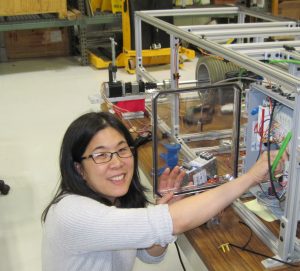
Fermilab scientist Lauren Hsu demonstrates the SuperCDMS SNOLAB calibration system prototype. Photo: Fermilab, Dan Bauer
“It is quite a challenge to design such a large cryogenics system to reach such cold temperatures using only materials that are nearly free of radioactivity and without constant access to the system,” said Fermilab physicist Matt Hollister, main designer of the cryogenic system for SuperCDMS SNOLAB.
Fermilab is also designing and fabricating electronics to control and read signals from the detectors. These electronics must have extremely low levels of noise in order to distinguish the small detector signals created by low-mass dark matter particles. The system for the new experiment is very compact, replacing a much larger chain of electronics modules from previous generations of CDMS.
“Reaching the low levels of electronic noise required for SuperCDMS is an ongoing challenge,” said Fermilab engineer Sten Hansen. “The levels we have achieved are due to the hard work of many throughout the collaboration.”
The response of the detectors to known particles must be understood to calibrate their expected response to dark matter particles. Fermilab is designing a system to allow the detectors periodic exposure to particle sources for such calibration.
“Previous generations of CDMS had to be calibrated manually,” explained Fermilab scientist Lauren Hsu. “The new experiment is designed so that calibration can be done more frequently and easily.”
A strong collaboration for extraordinary science
In addition to leading overall construction, SLAC National Accelerator Laboratory is building and testing the germanium and silicon detectors, and Pacific Northwest National Laboratory is helping to minimize and understand backgrounds for the experiment, a major challenge for the detection of faint signals from weakly interacting massive particles, also known as WIMPs, a candidate for dark matter.
Institutions in the United States, Canada, UK, France and India also play key roles in the experiment, working on all aspects of the experimental hardware as well as data analysis and simulation. The largest international contribution comes from Canada and includes the research infrastructure at SNOLAB.
“We’re pleased to be working closely with SNOLAB to manage the installation of this experiment,” said Fermilab scientist Pat Lukens, deputy project manager for SuperCDMS. “We’re eager to see the results of this next phase in the hunt for dark matter particles.”
Learn more about SuperCDMS at SLAC National Accelerator Laboratory’s website.
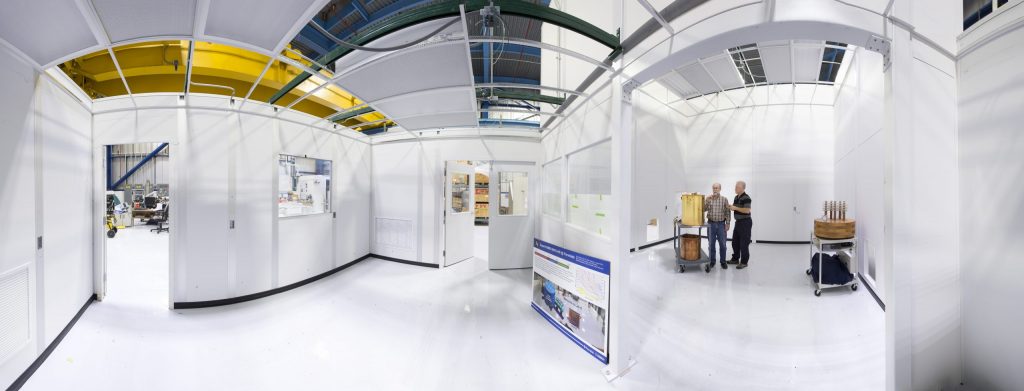
Fermilab’s Dan Bauer, spokesperson of the SuperCDMS SNOLAB experiment, and Mark Ruschman in the Lab G cryogenics testing cleanroom at Fermilab. Photo: Fermilab, Reidar Hahn
Fermilab is America’s premier national laboratory for particle physics and accelerator research. A U.S. Department of Energy Office of Science laboratory, Fermilab is located near Chicago, Illinois, and operated under contract by the Fermi Research Alliance LLC, a joint partnership between the University of Chicago and the Universities Research Association Inc. Visit Fermilab’s website at www.fnal.gov and follow us on Twitter at @Fermilab.
DOE’s Office of Science is the single largest supporter of basic research in the physical sciences in the United States, and is working to address some of the most pressing challenges of our time. For more information, please visit science.energy.gov.

